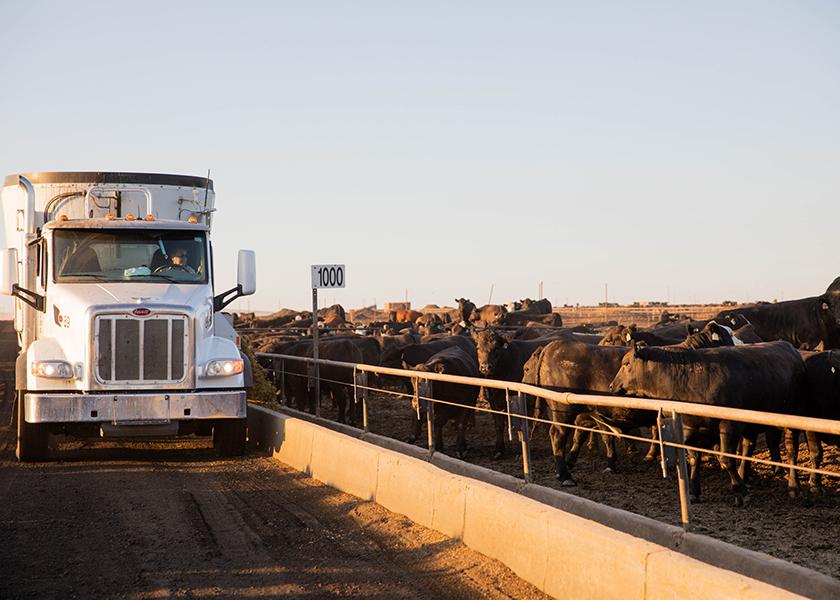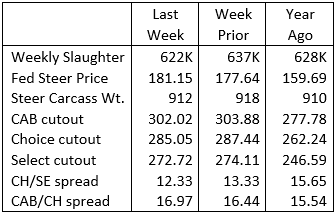CAB Insider: Quality Grades Diverge

The fed cattle market posted a strong upward move last week with prices $3 to $4/cwt. higher than the week prior. This was the culmination of cattle values recovering for multiple weeks, following the severely oversold December futures market.

February 2024 Live Cattle futures charted as many negative days as positive since the December 7 contract low through last Friday. Even so, the contract recovered $22/cwt. for the period to touch last Friday’s $184.62/cwt. high for the period’s rally. This week began on a softer note for the February contract but its premium to last week’s cash (including that of the April contract) is briefly supportive to the weekly negotiated cash trade.
With the challenge of deteriorated pen conditions and a resulting significant loss in feedlot performance during January, carcass weights have plunged.
Latest confirmed carcass weights for the week of January 22 indicate a combined steer/heifer carcass average of 878 lb., 28 lb. lighter than the December high. If head counts were equal on a weekly 490,000 head fed cattle slaughter, for example, the carcass weight change represents a 15,626 head decline in production volume. The impact to cattle price is similarly not insignificant.
Carcass cutout values have been under pressure so far in February following an increasing trend through the supply-challenged January market. Packer margins are negative and their need to push boxed beef values higher has been met with some resistance from buyers. February beef demand is lower than many other months and consumer beef prices are outpacing a year ago by a wide margin. With this being said, buyers will need to step in to begin securing beef needs relatively soon as the calendar marches on toward spring. Grilling demand is a few months off but the door will soon close for buyers looking to secure inventory at current price levels on popular grilling cuts.
Quality Grades Diverge
Extreme January weather conditions impacting a large portion of cattle feeding regions have been widely impactful to cattle feeders and the beef supply chain. Without discounting the seriousness of this, let’s focus momentarily on concurrent carcass outcomes.
In typical “very cold” weather periods carcass quality grades have a tendency to improve, rather than decline. However, this is not obvious in the January data where the percent USDA Choice carcass grade declined 1.47 percentage points compared to January 2023 (actually the first five weeks of the year). The seemingly small difference is large enough to be noted in the supply chain as a reversal of the quality improvement trend. It also draws into question the impact of cold weather events on carcass marbling scores, noted above as beneficial.

A closer look at the January data shows the percent USDA Prime grade, however, increasing by 0.94 percentage points for the same first five weeks of the year. This only confuses the issue, especially when the percent USDA Select also increased 2.42 percentage points, on average, for the period. The “Other” grade category (essentially “No Roll” carcasses) also increased by 0.05 percentage points for the same period versus 2023. The bottom line is that the “middle” grade USDA Choice declined while both Prime and Select grades showed measurable increases. This presents an interesting trend that’s difficult to explain.
A rearview look into the 2023 data shows that the USDA Choice quality grade percentage has underperformed in all but one week since early September 2023. The average difference each week was 0.71 percentage points. Again, USDA Prime outperformed the year prior for this period, but USDA Select was marginally lower by 0.24 percentage points.
The bottom line is that the January weather impact may have had some impact to the total Choice quality grade. There’s no reason to argue against it. However, the pattern of the total Choice grade underperforming expectations had been in place in the four months prior to the weather event.
The resilience in the Prime grade percentage is the data point that especially intriguing and hard to analyse at first look. In fact, Prime grade performance in Nebraska has been 12.5% since January 1st, compared to 8.5% for the period in 2023. Eastern Nebraska, home to some of the richest-grading cattle in the country, was especially hard hit by January blizzards. These outcomes are a curiosity, at the least, and challenge some assumptions if taken only at face value.








